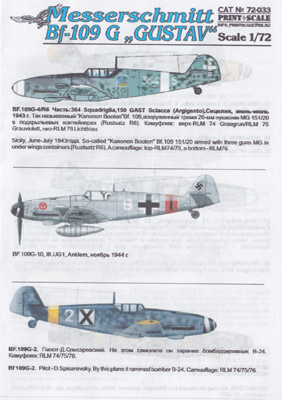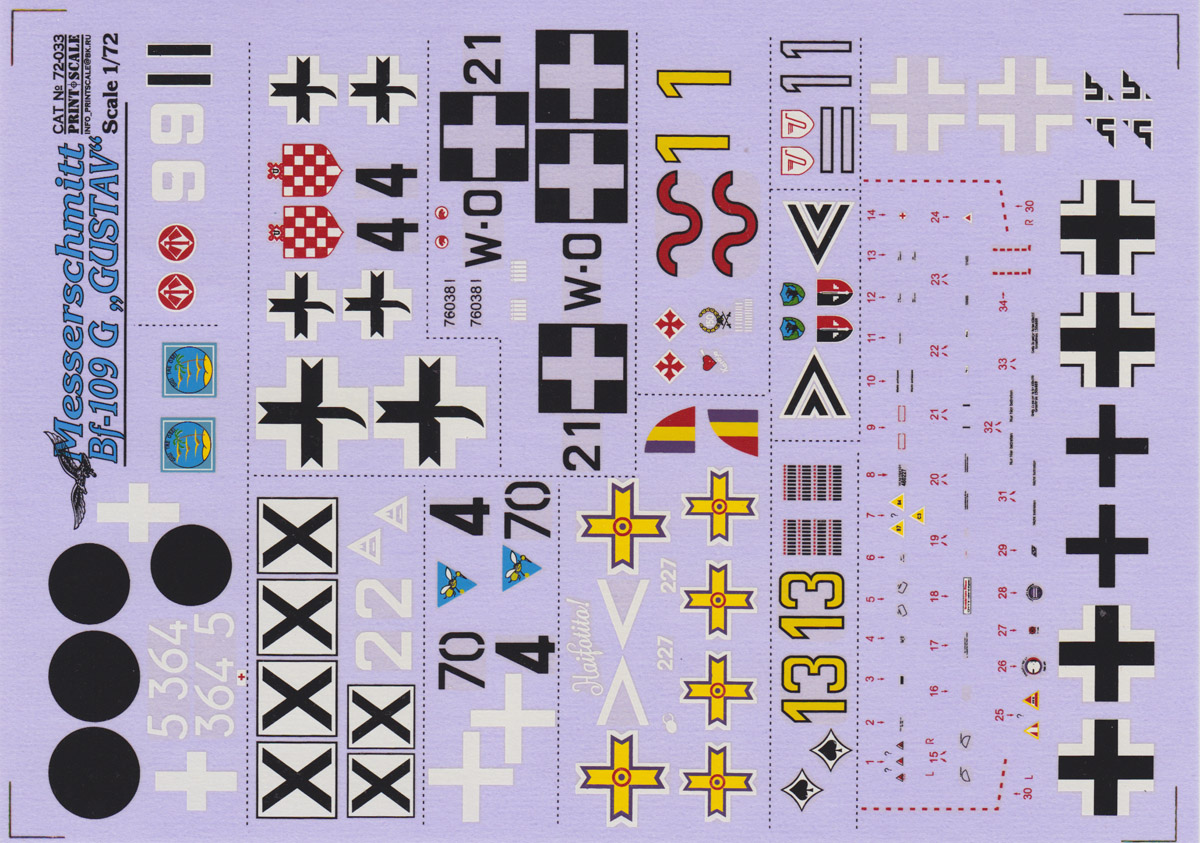
Print Scale 1/72 Messerschmitt Bf 109G "Gustav"
By Chris Banyai-Riepl
Overview
As the Second World War progressed, so did the development of the Messerschmitt Bf 109. The Bf 109G family was easily the most varied family, covering a big range of armament, engines, and airframe layout. This newest sheet from Print Scale examines the Bf 109G from many angles, with eleven examples from six different nations.
The Decals
The instructions lay out the eleven options in no apparent order, so I'll try to sort them out a bit for you. There are five German aircraft, two Italian aircraft, and one each from Hungary, Romania, Bulgaria, and Croatia. Starting with the German options, these include the following:
Bf 109G-2, Yellow 13, 3./JG 53, 1942
Bf 109G-2, Yellow 1, 9./JG 52, flown by Hermann Graf
Bf 109G-4, <<, I./JG 52, 1943
Bf 109G-6, Black 1 (outlined), 5./JG 3, 1943
Bf 109G-10, White 9, III./JG 1, 1944
The Bf 109G-10 is finished in overall RLM 76, while the other four are in the standard RLM 74/75/76 colors.
Moving on to the two Italian examples, these are the well-known 364-5, a Bf 109G-4/R6 seen at Sicily in summer of 1943. The second Italian one is Black 4/70, a Bf 109G-6/Trop, from Rome in late summer 1943. Both of these are finished in the standard RLM 74/75/76.
On to the individual nations, these include the following:
Bulgaria: Bf 109G-2, White 2, 74/75/76 camouflage
Croatia: Bf 109G-10/U3, Black 4
Romania: Bf 109G-2/R6, White <, 74/75/76 camouflage
Hungary: Bf 109G-6, W.0 + 21, 74/75/76 camouflage
With the basic information out of the way, attention must turn to the markings themselves. For some of the options, the decals are pretty accurate. Two of them, in fact, I have researched rather thoroughly, much to the benefit of Print Scale. These are the Bf 109G-4 from I./JG 52 and the Bf 109G-6 from 5./JG 3. These two aircraft are copied directly from my book on the Bf 109, both the profile illustration and the text (although without any crediting or permission from the source).
Unfortunately the level of research on some of the other options is not as good. Hermann Graf's aircraft, for example, has a correct Yellow 1 for the fuselage, but the decals have the Gruppe squiggle printed in red. This should be yellow, as it and the individual number were finished in the Staffel colors. A printing error has the Italian roundels as solid black circles instead of the proper Italian fasces. The Romanian option is pretty much all wrong, with the decals having purple instead of blue in the national insignia, the chevron the wrong angle, the name on the nose written incorrectly, and the pilot's (Ioan Di Cesare) brand resembling a legless scarab rather than his initials. Finally, the Bulgarian option has a white triangle for the tail, but this is heavily overdone. Whereas the decal sheet has a thick-stroke triangle with some bars, the actual aircraft had its serial number written in a thin-line triangle. The shape is right, it is just far too heavy-handed.
Conclusion
While it is commendable to provide a decal sheet with this many options on it, this sheet is a letdown in terms of research. While there are some great color profile illustrations out there, it is not wise to base decal research on them, as this sheet bears out. Artists make mistakes and can interpret things differently, and even in cases where the artist got it right, printing and scanning mistakes can significantly shift colors. The mistakes presented here are fairly simple ones that could have been avoided with a minimal amount of proper research. The wholesale lifting of other people's artwork is also frowned upon, especially since many artists would be happy to assist with productions such as this (which would also help minimize the mistakes made on this sheet). My thanks to Print Scale for the review sample, and I hope they improve their efforts in the future.

